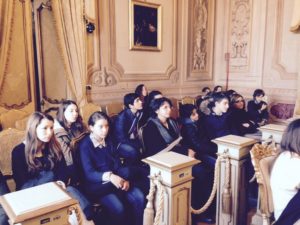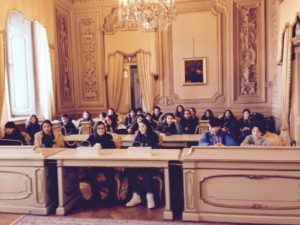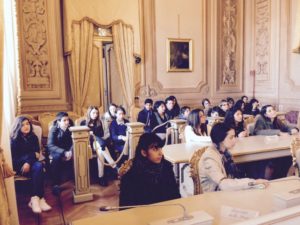 In March a group of our students visited the Italian Constitutional Court.
In March a group of our students visited the Italian Constitutional Court.
La Consulta is the term often used to refer to the Constitutional Court, and is taken from the name of the Court’s official residence at the Palazzo della Consulta in Piazza del Quirinale in Rome. The Palazzo della Consulta is an eighteenth-century building of great architectural beauty. Its physical location is an excellent symbolic expression of the institutional position of the Constitutional Court: it stands on Rome’s highest hill, the Colle del Quirinale opposite the Palazzo del Quirinale, official residence of the President of the Republic. Although the Court interacts with the world of politics, it is not itself a political institution in the strict term. Its function is to guarantee universal respect for the basic law of the Republic, the Constitution.
The Court is composed of fifteen judges. The system of nomination is a delicate balance designed to harmonize various needs: to assure that the judges are as impartial and independent as possible; to guarantee the necessary level of technical legal expertise; to bring a range of different knowledge, experiences, and culture to the Court.
 The judges are selected from a restricted category of legal practitioners with a high level of training and experience. These are judges or retired judges from the high levels of the judiciary (supreme magistrature), law professors, and lawyers with at least twenty years’ experience in legal practice.
The judges are selected from a restricted category of legal practitioners with a high level of training and experience. These are judges or retired judges from the high levels of the judiciary (supreme magistrature), law professors, and lawyers with at least twenty years’ experience in legal practice.
Each judge is appointed for a nine-year term of office with a mandate that cannot be renewed or extended; at the expiry of the term of office, a judge retires or returns to his former profession. The Court elects its President from among its members.
Who can invoke the jurisdiction of the Court?
The Constitutional Court is not free to decide autonomously which questions to examine, but must be called on to do so through specific procedures.
The Regions can contest laws of the State deemed prejudicial to their own autonomy guaranteed by the Constitution. In such cases constitutional proceedings are designed to resolve disputes between the State and the Regions.
Any judicial authority who must resolve a dispute that requires the application of a legal provision, where there is doubt as to that provisions’ constitutionality, has both the power and the duty to certify that question to the Constitutional Court.
 When the Court declares a law unconstitutional, the law in question automatically loses effects from the day after the publication of the Court’s decision in the Gazzetta Ufficiale. That means that the law can no longer be applied by any judicial organ.
When the Court declares a law unconstitutional, the law in question automatically loses effects from the day after the publication of the Court’s decision in the Gazzetta Ufficiale. That means that the law can no longer be applied by any judicial organ.
When the Court declares the certified question unfounded, the law remains in force.
During our visit we also saw the Palace of the Constitutional Court. Among the beautiful rooms we visited, there are the Sala delle udienze, where the judicial hearing takes place; the Salotto verde (so called from the colour of the wall) which links the President’s Salotto rosso (Red room); the Salone Pompeiano where the Court meets in closed session and finally the Salone del Belvedere on the top floor, where the terrace affords one of the best views of Rome.
Lascia un commento